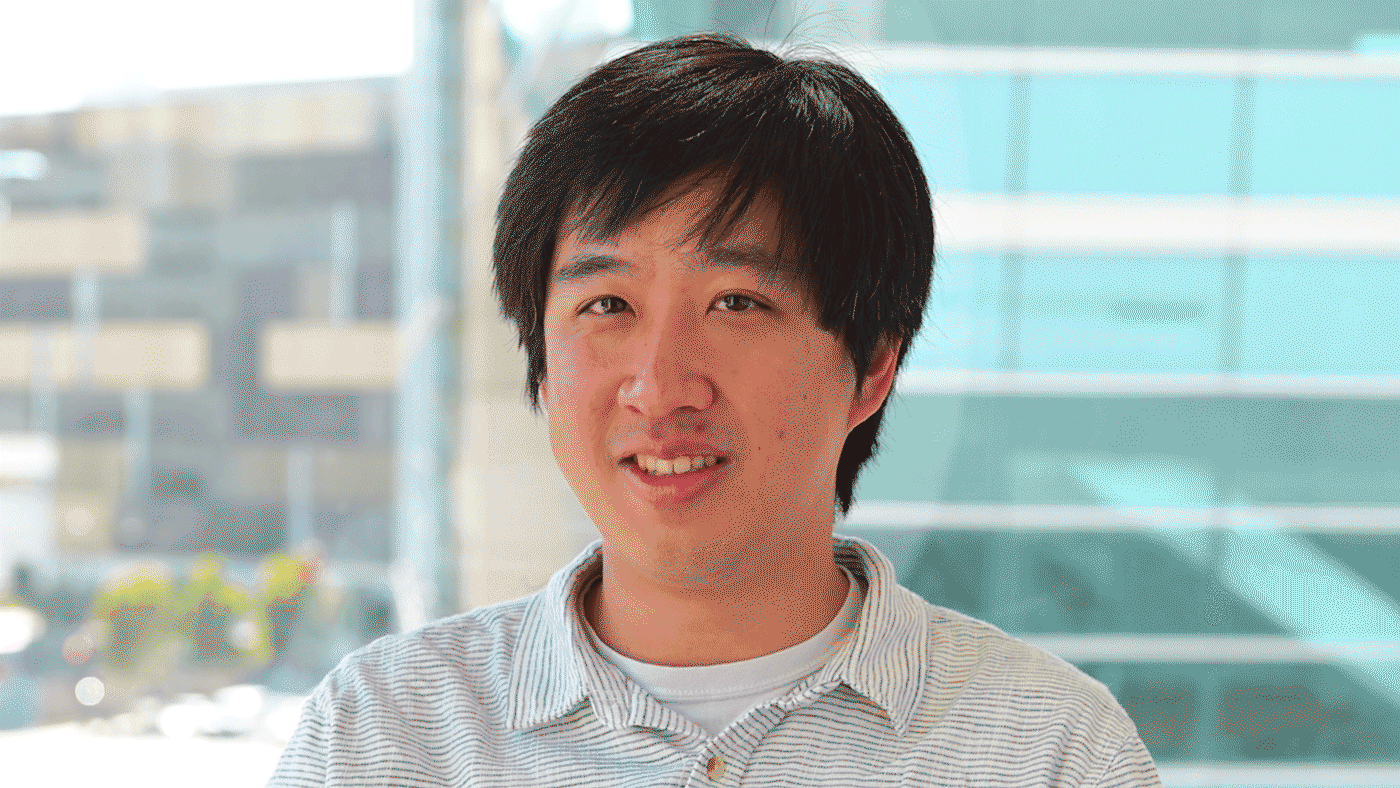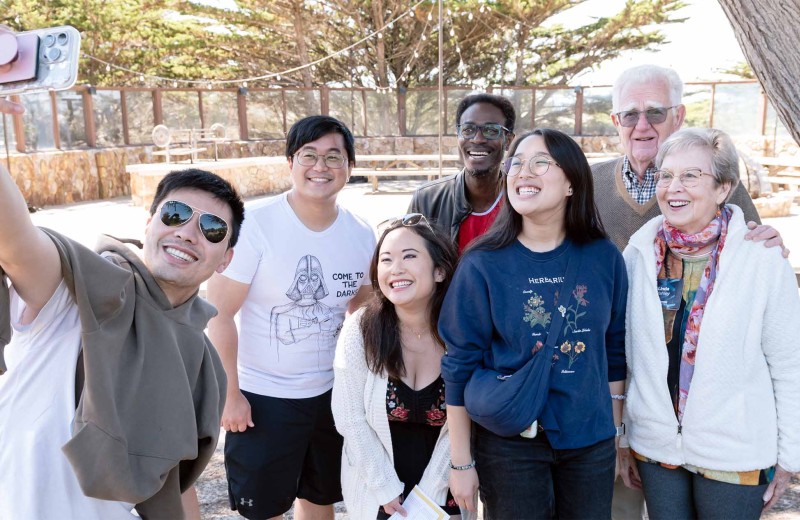Gladstone NOW: The Campaign Join Us on the Journey✕

Marty Yang, a postdoc in the Ramani lab, shares the path that led him to Gladstone, his future career goals, and how he wishes he could have a conversation with Charlie, his goldendoodle.
Marty Yang (he/him), PhD, is a bioinformatics fellow in the lab of Vijay Ramani, PhD. Yang grew up in Toronto, Canada, and studied neuroscience as an undergraduate at Duke University. During that time, he became fascinated with the genetics that enable the development and maturation of myriad cell types in the mammalian brain. This led him to pursue a PhD at Harvard Medical School, where he worked on understanding how genetic variation controls gene regulation.
What brought you to Gladstone?
Toward the end of my graduate studies, I became unsatisfied with the resolution of existing methods for answering genome-scale questions. I realized many of the questions that I wanted to address were only possible at single-molecule resolution. I was inspired by Vijay Ramani’s work as a Sandler fellow (and later as a Gladstone investigator), and I was eager to apply methods that his lab had developed in my own postdoc within the context of brain development.
What do you like about Gladstone?
I enjoy how collaborative the environment is to do science at Gladstone. All the colleagues I have interacted with have asked insightful questions that have motivated some of the questions and approaches that I’ve applied to my own projects.
Were you interested in science as a child?
I recently looked back at a yearbook from when I was in first grade—I had written that I wanted to become a math professor when I grew up. I guess I would say (even from an early age), I was curious about learning how numbers worked.
Why did you decide to go to graduate school?
The path for me to pursue a PhD was somewhat circuitous. I had wanted to become a physician (more specifically, a pediatrician) in college, and I actually attended medical school for a year. It was during this time that I felt drawn to ask why we currently lack effective therapies for some conditions, as well as how cellular function can go awry in the disease state. This made me realize that I was more interested in making discoveries in basic science to further our understanding of the molecular mechanisms that underlie human disease.
Can you describe your current research project?
In mammals, genomic DNA from a single cell is about 2 meters long and has to be packaged to fit within an approximately 10 micron nucleus. We hypothesize that how our genomes are structured can underlie the development of different cell types in our body (e.g. neurons in our brain, hepatocytes in our liver) from cells that share the same genetic code.
In particular, we have developed a new sequencing technology to examine how our DNA is structured after DNA replication, a fundamental process that is required for all replicating cells within our body to divide. Many of the critical proteins that allow our DNA to be compacted are displaced upon replication (by the replication machinery), and our goal is to understand when and how they can repopulate our genomes.
What or who influenced your decision to work in science?
This is largely similar to my rationale for going to graduate school—I want to make discoveries in basic science that have the potential (in the long run) to result in novel therapies for human disease, especially for neurodevelopmental disorders.
What do you do when you’re not working?
These days, I’m usually out with my partner, Emmy, and my new puppy (his name is Charlie, and he is a mini goldendoodle) on a walk or playing at the dog park. Charlie also attends puppy preschool and was an honor student!
If you could learn to do anything, what would it be?
I wish I could learn to understand what Charlie is thinking at all times. Training him has been a fun, but challenging, process, and I sometimes wish we had a better way to communicate with each other.

Charlie, Yang's goldendoodle puppy.
What is your hidden or unique talent?
I wouldn’t say it is hidden or unique per se, but I started playing Pokemon competitively (during the pandemic) in grad school. For those who are curious, I think there are still a couple YouTube videos out there of me competing in Go tournaments.
If you could meet any scientist from any point in time, who would it be and why?
Rosalind Franklin. As someone who works on chromatin structure, none of what I do today would be possible without her fundamental contribution to the discovery of the double-helix structure of DNA. I wish I could have been there to witness some of her initial X-ray diffraction images as they were being taken to learn more about Franklin’s thought process.
September 18–22 is Postdoc Appreciation Week. What are your career goals after you complete your postdoc at Gladstone?
I want to run my own laboratory to examine gene regulation and neuronal development at single-molecule resolution, and to mentor the next generation of scientists.
How does Gladstone support its postdoc population?
I want to specifically acknowledge the work done by the Sponsored Programs and Research Compliance department at Gladstone. They have been instrumental in my time as a postdoc, and their feedback has been invaluable in my fellowship applications.
Want to Join the Team?
Our people are our most important asset. We offer a wide array of career opportunities both in our administrative offices and in our labs.
Explore CareersMeet Gladstone: Oscar Yip
Meet Gladstone: Oscar Yip
Oscar Yip is advancing Alzheimer’s research in Yadong Huang’s lab at Gladstone while drawing inspiration from his family, community, and his broader goal of helping patients.
Graduate Students and Postdocs Profile Alzheimer’s DiseaseFrom Mentorship to Legacy: Creating Opportunity for Early Career Scientists
From Mentorship to Legacy: Creating Opportunity for Early Career Scientists
Robert and Linda Mahley’s commitment to trainee development continues through Gladstone’s annual Career Advancement Awards.
Graduate Students and Postdocs HistoryWhen Brain Cells Talk: NOMIS-Gladstone Fellow Yuliya Voskobiynyk on Decoding Microglia’s Secret Signals
When Brain Cells Talk: NOMIS-Gladstone Fellow Yuliya Voskobiynyk on Decoding Microglia’s Secret Signals
NOMIS–Gladstone Fellow Yuliya Voskobiynyk, PhD, shares her journey from Ukraine to Gladstone and how her research on microglia could shed light on brain function and diseases like epilepsy and Alzheimer’s.
Graduate Students and Postdocs Profile Neurological Disease NOMIS



